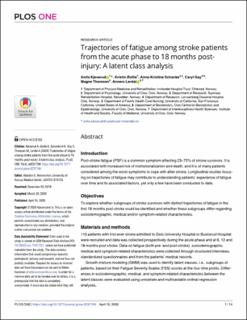| dc.contributor.author | Kjeverud, Anita | |
| dc.contributor.author | Østlie, Kristin | |
| dc.contributor.author | Schanke, Anne-Kristine | |
| dc.contributor.author | Gay, Caryl | |
| dc.contributor.author | Thoresen, Magne | |
| dc.contributor.author | Lerdal, Anners | |
| dc.date.accessioned | 2020-09-29T14:20:17Z | |
| dc.date.available | 2020-09-29T14:20:17Z | |
| dc.date.created | 2020-04-25T12:31:02Z | |
| dc.date.issued | 2020 | |
| dc.identifier.citation | PLoS One . 2020 Apr 15;15(4):e0231709. | en_US |
| dc.identifier.issn | 1932-6203 | |
| dc.identifier.uri | https://hdl.handle.net/11250/2680370 | |
| dc.description.abstract | Introduction: Post-stroke fatigue (PSF) is a common symptom affecting 23-75% of stroke survivors. It is associated with increased risk of institutionalization and death, and it is of many patients considered among the worst symptoms to cope with after stroke. Longitudinal studies focusing on trajectories of fatigue may contribute to understanding patients' experience of fatigue over time and its associated factors, yet only a few have been conducted to date.
Objectives: To explore whether subgroups of stroke survivors with distinct trajectories of fatigue in the first 18 months post stroke could be identified and whether these subgroups differ regarding sociodemographic, medical and/or symptom-related characteristics.
Materials and methods: 115 patients with first-ever stroke admitted to Oslo University Hospital or Buskerud Hospital were recruited and data was collected prospectively during the acute phase and at 6, 12 and 18 months post stroke. Data on fatigue (both pre- and post-stroke), sociodemographic, medical and symptom-related characteristics were collected through structured interviews, standardized questionnaires and from the patients' medical records. Growth mixture modeling (GMM) was used to identify latent classes, i.e., subgroups of patients, based on their Fatigue Severity Scales (FSS) scores at the four time points. Differences in sociodemographic, medical, and symptom-related characteristics between the latent classes were evaluated using univariate and multivariable ordinal regression analyses.
Results and their significance: Using GMM, three latent classes of fatigue trajectories over 18 months were identified, characterized by differing levels of fatigue: low, moderate and high. The mean FSS score for each class remained relatively stable across all four time points. In the univariate analyses, age <75, pre-stroke fatigue, multiple comorbidities, current depression, disturbed sleep and some ADL impairment were associated with higher fatigue trajectories. In the multivariable analyses, pre-stroke fatigue (OR 4.92, 95% CI 1.84-13.2), multiple comorbidities (OR 4,52,95% CI 1.85-11.1) and not working (OR 4.61, 95% CI 1.36-15,7) were the strongest predictor of higher fatigue trajectories The findings of this study may be helpful for clinicians in identifying patients at risk of developing chronic fatigue after stroke. | en_US |
| dc.description.sponsorship | Anita Kjeverud has received a PhD scholarship from Innlandet Hospital Trust, Ottestad, Norway. Anners Lerdal has received funding from the Research Council of Norway (Grant #176503), the Leif Eriksson Scholarship Grant (RCN, Grant #19256) and Buskerud University College, Drammen, Norway. The other authors received no specific funding for this work. | en_US |
| dc.language.iso | eng | en_US |
| dc.rights | Navngivelse 4.0 Internasjonal | * |
| dc.rights.uri | http://creativecommons.org/licenses/by/4.0/deed.no | * |
| dc.title | Trajectories of fatigue among stroke patients from the acute phase to 18 months post-injury: A latent class analysis | en_US |
| dc.type | Peer reviewed | en_US |
| dc.type | Journal article | en_US |
| dc.description.version | publishedVersion | en_US |
| dc.rights.holder | © 2020 Kjeverud et al. This is an open access article distributed under the terms of the Creative Commons Attribution License, which permits unrestricted use, distribution, and reproduction in any medium, provided the original author and source are credited. | en_US |
| dc.source.pagenumber | 1-14 | en_US |
| dc.source.volume | 15 | en_US |
| dc.source.journal | PLOS ONE | en_US |
| dc.source.issue | 4 | en_US |
| dc.identifier.doi | 10.1371/journal.pone.0231709 | |
| dc.identifier.cristin | 1808011 | |
| cristin.ispublished | true | |
| cristin.fulltext | original | |
| cristin.qualitycode | 1 | |

